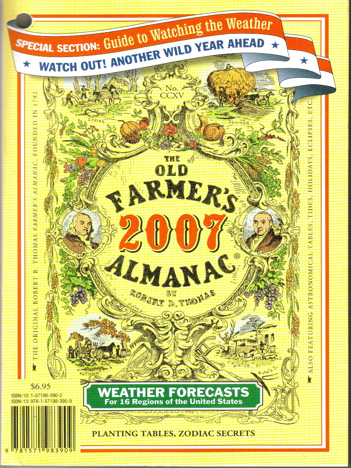
As the pioneers headed westward from Connecticut to settle in the new Western Reserve Territory at the beginning of the 19th Century, they had one purpose in mind and that was to find better farm land and raise more food for their family. They arrived in Town One; Range One carrying very few possessions, but the one item they made sure not leave behind was their Farmer’s Almanac. It was their bible. It told them when to plant and when to harvest. The farmers in New England had learned to trust their almanac and if it worked back in Old Connecticut, they reasoned that it was sure to work here in what was called New Connecticut. The most trusted almanac at that time was the one printed by Robert B. Thomas of Dublin, New Hampshire. Today it is called The Old Farmer’s Almanac.
Who was Robert B. Thomas?
Thomas was born nine years before the American Revolution in Grafton, Mass. He had a fascination for astronomy and at an early age decided to write an almanac. With that in mind, he became a bookseller, taught school, built a store and bindery and in early 1792, at the age of 26, went to Boston to study mathematics. That fall he delivered to the printers Joseph Belknap and Thomas Hall the first edition of what he then called The Farmer’s Almanac. For a few years, the only payment he received was one-tenth of the copies printed which he then sold in his store for nine cents apiece.
Eventually, the Almanac made Robert B. Thomas a prosperous man with his almanac being his primary means of support. For 54 years he was its editor and died at the age of eighty while proof reading the 1846 Edition. He was buried with his wife Hannah, his wife of forty-three years, in the cemetery at Sterling, Massachusetts.
What is an Almanac?
Webster states an almanac is a book containing a calendar of days, weeks, and months to which astronomical data is added. The first calendars appeared more than five thousands years ago. Soon after, astronomical phenomena were added. The difference, then and now, is that while a calendar records time, an almanac records and predicts astronomical events, tides, and weather with respect to time. A calendar may exist without almanac information, but not the reverse. So today when you see a publication without astronomical or calendar information calling itself an almanac – it isn’t.
The concept of an almanac was not novel in Robert B.Thomas’s time. If the truth be known, there was another Thomas putting out another “farmer’s almanac.” This competitor’s name was Isaiah Thomas (no relative). He fought with the minutemen at Lexington, and later published many books, including The History of Little Goody Two-Shoes. But Isaiah’s almanac was fraught with errors in his astronomical calculations, so said Robert in his first publication. Isaiah fought back, but having made fifty-six errors, his credibility was destroyed and within a few years was out of the almanac business. By 1803 Thomas was able to write that his sales were “unprecedented by any other ‘Almanack’ published in the United States.”
Predicting the Weather
The Old Farmer’s Almanac is best known for its accuracy in predicting the weather some 16 months in advance of going on sale the second Tuesday of September. The 2007 edition, which is now available at most book stores, covers the period of October 2006 to December 2007. Would you like to learn what will happen this winter? Well, on page 184, the almanac says, “December through March will be colder than normal, on average, in all areas except northern New England, Florida, and southern Texas. Snowfall will be below normal in the High Plains, much of the eastern Great Lakes and the Southwest, near normal in the Ohio Valley, and above normal in other areas that normally receive snow.” Then turning to page 191, the following weather is predicted, “The coldest temperatures will be around Christmas and in early and mid- to late January and early and late February. The heaviest general snowfall will be in mid-December, early and late January and mid-February.” Let’s see how close their predictions are to the actual weather this winter. Last winter we know the Almanac was accurate in more than 99% of the country when forecasting snowfall.
To predict the weather during the late eighteenth century the farmers would take into account nature’s signs, observing the thickness of the skin on onions, the width of stripes on the woolly caterpillar and the change from one moon phase to the next. Thus weather forecasting in 1792 was what you might call an imperfect science. Then Thomas came along with his formula based on a complex series of observed New England weather cycles. He also believed that weather on Earth was influenced by sunspots, which are magnetic storms on the surface of the Sun. In the 1793 preface, Thomas writes, “I need say but little; for you will, in one year’s time, without any assistance of mine, very early discover how near I have come to the truth.”
His formulas have been enhanced over the years by state-of-the-art technology and modern scientific calculations. Today the Almanac employs three scientific disciplines; solar activity, climatology, the study of prevailing weather patterns; and meteorology, the study of the atmosphere. Today the staff of the Almanac admits that they can not predict the weather with total accuracy, but claim that their predictions are almost always very close to 80%.
